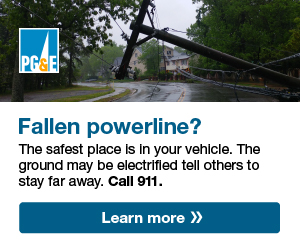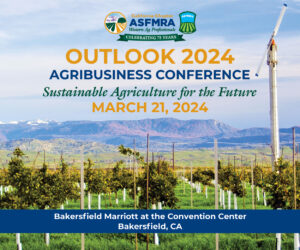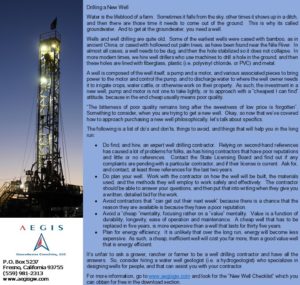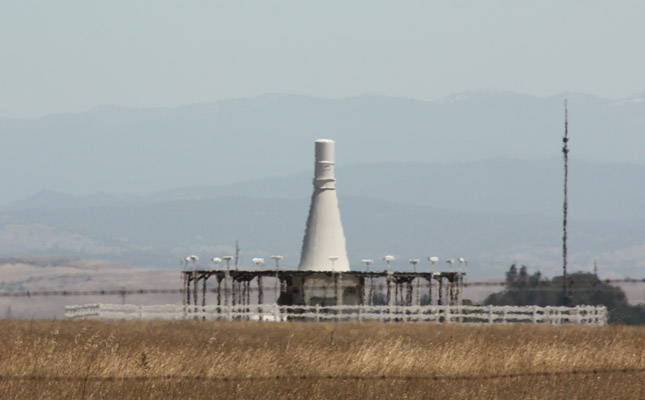 Madera GSA Approves Water Recharge Credit Policies
Madera GSA Approves Water Recharge Credit Policies
By Joel Hastings
At a meeting of the Madera County board of supervisors held March 19, 2024, the Madera GSA adopted policies to give landowners credit for water recharged since January 1, 2023. Growers will receive at least a 75 percent credit against their allocation and may receive up to 90 percent depending on soil suitability. Two policies approved provide credits for recharge from purchased water or from flood water. Landowners will be required to specify amounts recharged as metered, the location of storage in basins or fields along with other details requiring documentation. There was a good bit of public discussion, and the final vote was not unanimous. Here’s how it went.
recharge from purchased water or from flood water. Landowners will be required to specify amounts recharged as metered, the location of storage in basins or fields along with other details requiring documentation. There was a good bit of public discussion, and the final vote was not unanimous. Here’s how it went.
Newly reelected Supervisor Rob Poythress chaired the supervisors meeting, calling it to order at 10:00 a.m. in the auditorium of the county government office building on 4th Street in Madera. After the invocation and pledge, Igal Treibach came to the podium for public comment. He said that the supervisors represent all the citizens in the county and that he hoped that in considering recharge credits, they would consider not only agriculture but also those developers who work to bring in new water.
After conducting other business, the board moved into the GSA session about 10:30 a.m. with Stephanie Anagnoson, county director of water and natural resources, making the initial presentation to the board and the audience. She recounted the process leading to the proposed policies, beginning with an emergency recharge regulation implemented in January 2023 at the beginning of what turned out to be a very wet year. The proposed recharge rate was 75 percent of water applied for a credit that would expire if not used by the end of the year.
Feedback at that time according to Anagnoson was the proposed credit should be higher, upwards of 100 percent, the credit should be able to roll over into the future and there should be no additional restrictions on dairies. Staff were complimented for making a prompt proposal, she said, and they were directed to come back with a permanent policy available beyond 2023.
She said research with experts and public discussions began immediately. Studies by academics were of short duration and on sandy soils showing recharge occurring at rates up to 90 percent of applied water on grapes and almonds. A study by Helen Dahlke et al. showed that the Soil Agricultural Groundwater Banking Index (SAGBI) may be a reliable indicator of soil suitability.
She said that most counties, irrigation and water districts do not have recharge credit policies yet to use as reference because many do not have allocations. But Tulare ID offers credits depending on time of year and the on-farm facility. Westlands Water District has a number of recharge programs including a 75 / 25 policy that pays growers to take water for recharge in exchange for a purchased water credit. Westlands also found that approximately 75 percent of the water applied was recharged.
Also last year, staff worked with non-governmental organizations and state agencies on language that could be helpful in reducing flood risk and increasing recharge. Two executive orders from the governor’s office allowed growers to take water for recharge off waterways when flooding was threatened. Even without credits in place, growers took water for recharge in 2023, she said. The documentation on amounts and locations is still being analyzed, she said.
After meeting with the science experts, individual growers, Farm Bureau, the Madera Ag Water Association and Red Top Landowners and seeing the benefits of actual recharge, a permanent set of policies was drafted by staff. Key elements are actually two policies, credits for purchased water and credits for “flood water.” The policies are for farm units in the Madera County GSA and are retroactive to January 1, 2023. Recharge credits range from a minimum of 75 percent to a maximum of 90 percent with additional documentation. Credits can be carried over from year to year and there are no additional restrictions on dairy farms other than current laws.
from a minimum of 75 percent to a maximum of 90 percent with additional documentation. Credits can be carried over from year to year and there are no additional restrictions on dairy farms other than current laws.
A specific requirement included in the draft regs proposed is a requirement that extraction is limited to the aquifer in which the recharge occurred, either above the Corcoran Clay layer or below. Wells that have screens at both levels will be considered to be extracting from below the layer. Detailed in Paragraph 5 of the proposed policy, this point came up in discussion from the public and among the supervisors.
Anagnoson cited the outbound messaging to growers and their organizations, public meetings and a resource fair on March 6 attended by over 75 people with the goal of getting the word out on these proposals which were on the supervisors’ agenda for action at this meeting with a staff recommendation for adoption.
Lots of Discussion
Chair Poythress invited discussion from the supervisors with David Rogers leading off. He thanked the staff for the work and the draft saying recharge is the best way to get “new water” into the ground. “The best storage is under our feet,” he said. He said his one concern was the requirement that water must be extracted from the aquifer into which it was deposited. He said much of the land in his district around the Chowchilla Subbasin has land with both the upper and lower aquifers.
Supervisor Jordan Wamhoff asked for Anagnoson’s reaction to the comments and letter from Mr. Treibach. She replied that the GSA can’t develop policy for the whole county, but the county development authority can and has. A staff member from that department said a policy had been implemented in 2017 covering housing developments on land both irrigated and never-irrigated that requires water balance. He said the county’s regulations are stronger that those from the state.
Supervisor Robert Macaulay said he believes there is still opportunity to incentivize those who develop never-irrigated land.
With that, Chair Poythress invited public comment with Mr. Treibach once again leading off. He said we are lucky to have the staff we have which deserve accolades for the work they have done. He read a portion of an email he said he had received from Farm Bureau saying that by 2030 as many as 68 percent of family farm units [we think he was referring to California] would be sold or going out of business. He urged that Madera County do everything possible to help any organization bringing water into the county or stimulating recharge.
Speaking for the Madera Ag Water Association, Noah Lopez suggested that all the rules and regs for water use in the GSA be compiled into a comprehensive directory for landowners. He said that while land owners have the option to select either Irriwatch or Land IQ for satellite measurement of water use, they can only see the results of the one they choose, even though the $23 / acre fee pays for both. He believes growers should see both results. He asked if there were any projections of the impact of this program. He continued saying he hoped that the additional pumping that the recharge credit program could allow would not make the basin any worse of.
Mark Nakata introduced himself representing the California United Water Coalition. He said a lot of recharge was done without any firm knowledge of what the credit was going to be. He said growers have wells drawing both above and below the Corcoran Clay layer and the expense of those wells needs to be considered.
Local grower and Coalition board member Ryan Jones said the burden of recharge has been put on the shoulders of farmers. The costs are unbelievable, he said. He pointed out that currently we’re looking at the worst downturn in the ag economy in his lifetime. He said you can’t recharge if you don’t have the money. He finished by asking what the GSP says about how the Corcoran Clay layer is to be managed.
said you can’t recharge if you don’t have the money. He finished by asking what the GSP says about how the Corcoran Clay layer is to be managed.
Saying his family had been farming in Madera since 1912, Robert Bishel pointed out that all the creeks and river beds in the county are lined with sand which supports recharge. He pointed out the difference of 200 feet of elevation between the east side of the county and the west side, so water tends to move west. He said water quality is an issue with arsenic concentrations under the Madera Ranchos, so the aquifer needs to be raised. He said that when property development puts in more septic systems, farmers have to pay the bill.
Larkin Harmon said her farmland is near the San Joaquin River but even so, the cost of bringing in flood water includes temporary pumps, the diesel to run them and the labor required, taken away from regular farm work. She said no one helps with these costs. Now [for the extra 15 percent credit] she has to pay the costs of obtaining the geological testing for the percolation rates of her sand. She said the recharge credit should be 85 percent. She said recharge is the only positive thing from SGMA. She asked the supervisors to consider the farm economy. “Throw us a bone,” she concluded.
Dairyman Larry Petrowski farming on the west side said he had a particular concern about “Paragraph 5,” the requirement that water extracted come from the same level as water recharged. He said like many farms in his area, he has wells with screens on both sides of the Corcoran Layer. He said for deep wells with multiple screens you can’t prove where they are pulling from. He said that last year he recharged a substantial amount of water so that the water level in his deep wells is up 30 feet while his shallower wells are flush now.
Mickey Basra said he had farmland in both the Madera and Chowchilla Subbasins. He offered two acres of his sandy loan soil without charge if the county would put in a recharge basin.
Devin Aviles of Agri-World Cooperative. said all recharge is good recharge. He said he hopes property developers are indeed required to observe the requirements of the regulation passed in 2017.
Speaking online, Sarah Woolf identified herself as a farmer in the Red Top area of the Chowchilla Subbasin. She complimented the staff for this policy. She said working with the Triangle T Water District, they’ve moved towards extractions only from the upper aquifer to stop subsidence. She said to reach sustainability and stop land subsidence, pumping in the lower aquifer has to stop. She urged the adoption of this policy so growers would receive a benefit. She said pass the policy as it is presented.
Also online, Christina Beckstead, executive director of the Madera County Farm Bureau, said she was slightly disappointed with the draft. She said FB had been asked to facilitate grower input throughout the county and they had advocated for a simpler policy. Regarding subsidence, she said wells straddling both aquifers need to be considered. She said farmers having to pay another five to ten thousand dollars to document percolation is a problem.
Back in the meeting, grower Sohal Samran asked Stephanie if she had reached out to the Madera Irrigation District and the Chowchilla Water District. He said they have the water and the infrastructure… we need their help. Supervisor Rogers said that CWD had provided free flood water, but he didn’t know about MID. A price of $200 was mentioned. [Editor’s note: MID had provided water for its customers at $10 / AF late in the season until the end of the year]
and the infrastructure… we need their help. Supervisor Rogers said that CWD had provided free flood water, but he didn’t know about MID. A price of $200 was mentioned. [Editor’s note: MID had provided water for its customers at $10 / AF late in the season until the end of the year]
Supervisor Macaulay asked about helping farmers with the costs of documenting percolation using grant funds. Anagnoson pointed out that SAGBI is free and that she can look for grants.
With no further public comment, Chair Poythress invited a motion. Rogers moved to adopt the resolution but suspending Paragraph 5 requirements for three years in order to obtain more information. Poythress asked staff what the impact of suspending Paragraph 5 would be. Anagnoson said that the state is pretty concerned about subsidence. Rogers commented that recharge had been done with the expectation of credits. “I think we need to move in the direction of pumping above the Corcoran Clay,” he said. Anagnoson added that without Paragraph 5, subsidence will be exacerbated.
Poythress responded saying that shallow wells and deep wells have been an issue for years and suspending Paragraph 5 would “simply kick the can down the road.” Rogers claimed that in parts of the Chowchilla Subbasin, subsidence had been halted. Anagnoson said that with changes in pumping in the Triangle T area, hot spots of subsidence had simply been moved to areas still extracting deep water.
Consultant John Davids of Davids Engineering via Zoom added that while he was not advocating for policy, as a point of information the Madera Subbasin GSP commits to stopping subsidence.
Two more comments were allowed from the public. Ryan Jones said that within MID boundaries there are hundreds of wells pumping below Corcoran Clay. Larry Petrowski said that his allocation doesn’t specify between upper or lower level pumping. He said the science on this is not settled. He finished saying, “Let’s get the data and err on the side of farmers.”
With that, Rogers amended his motion to suspend Paragraph 5 for one year, not the three he had proposed earlier. Supervisor Wamhoff asked about support for a simple 85 percent credit. Poythress said the reason for the variation in the credit rate is because of the variation in the topography across the county. Wamhoff said he wanted to get the opinion of others and to focus on the incentive to recharge. Poythress said there is no disincentive at the 75 percent rate, especially when free or cheap water is available.
Rogers said if we don’t put a policy in place that doesn’t leave water in the basin, we’re shooting ourselves in the foot. I think we’ve done it right so far. “[Paragraph 5] is hard to regulate and hard to ascertain,” he said.
Wamhoff seconded the motion which really is a two-year suspension of Paragraph 5… 2023 and 2024. Discussion confirmed that Paragraph 5 would be become effective on January 1, 2025. With that, the chair called for a roll call vote which showed Rogers, Wamhoff and Poythress in favor while Letitia Gonzalez and Macaulay voted no. It was declared passed by the vote of three to two at 12:30 p.m. The meeting reconvened as the regular board of supervisors session for a few more items of business and then moved to another closed session with nothing to report at the end.
DISCLAIMER OF RESPONSIBILITY; Waterwrights strives to provide clients with the most complete, up-to-date, and accurate information available. Nevertheless, Waterwrights does not serve as a guarantor of the accuracy or completeness of the information provided, and specifically disclaims any and all responsibility for information that is not accurate, up-to-date, or complete. Waterwrights’ clients therefore rely on the accuracy, completeness and timeliness of information from Waterwrights entirely at their own risk. The opinions expressed in this report are those of the author and do not represent any advertisers or third parties.
ALL RIGHTS RESERVED. Copyright 2024 by WaterWrights.net
Madera County is comprised of three subbasins, designated by the CA Department of Water Resources as critically overdrafted, and “high priority”: (1) the Chowchilla Subbasin; (2) the Madera Subbasin; and (3) a portion of the Delta-Mendota Subbasin. Each of these subbasins submitted a Groundwater Sustainability Plan (GSP) by January 31, 2020. These subbasins are required to achieve “sustainability” by the year 2040. The methods by which sustainability will be achieved are illustrated in the GSPs, which were drafted in partnership by the irrigation districts, water districts, cities and Madera County. The Madera County Groundwater Sustainability Agency (GSA) is administered by the Madera County Department of Water and Natural Resources: Stephanie Anagnoson, Director, 200 W. Fourth Street, Madera, CA 93637, (559) 675-7703 x. 2265 or (559) 675-6573. The County of Madera Board of Supervisors is the Board of Directors of the GSAs for the three subbasins. The current board is composed of five members: Robert Poythress, chair, Letitia Gonzalez, Robert Macaulay and David Rogers.
DWR SGMA #s – Chowchilla Subbasin 5-022.05, Madera Subbasin 5-022.06 & Delta Mendota Subbasin 5-022.07





























